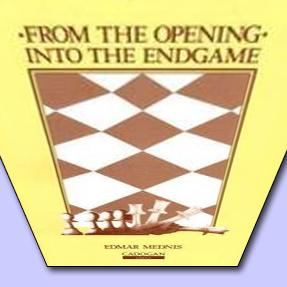
From Opening to Endgame: the c3 Sicilian
The Alapin Sicilian (1.e4 c5 2.c3) is an opening which particularly often leads to the transposition to a queenless middlegame. There are quite a few theoretical lines which lead to an early queen exchange, while keeping a tough, fighting game. In the future, I may be returning to this subject - this week I will be dealing with the interesting ending which occurs after the moves 1.e4 c5 2.c3 d5 3.exd5 Qxd5 4.d4 Nf6 5.Nf3 Bg4 6.dxc5 Qxd1+ 7.Kxd1:
There are several variations of the Alapin where dxc5 leads to a queenless middlegame. For instance, the same position could be reached with a black knight on c6 instead of f6, or with the bishop back on c8 and the knight still on g1. I have chosen to examine the above line, which is perhaps the most commonly-reached of those dxc5 possibilities.
Despite the exchange of queens, these queenless middlegames are razor sharp. For example, I think the only time in my life where I have lost entirely due to prepared analysis was in one of these lines (with the knight on c6), against IM Vladimir Sveshnikov, the son of one of the world's foremost 2.c3 experts GM Evgeny Sveshnikov.
First of all, Black is down a pawn. This pawn on c5, if consolidated, would not only form a very dangerous pawn phalanx, but also restrict the development of Black's dark-squared bishop. Another important factor in White's favor is that Black often needs to seek counterplay by playing ...e7-e5, but this pawn itself can often be a target.
At the same time, the white king is disturbed and cannot castle, and Black is slightly ahead in development. An important role is played by the b1-h7 diagonal - the white king can hardly be safe there, due to the chance for Black to check on f5, for instance. Additionally, Black has the opportunity to undermine the queenside pawns by ...a7-a5 (after b2-b4).
Very important, naturally, is the pin on the f3 knight. In practice most games continue with 7...e5 8.b4 e4 9.h3 Bh5 10.g4 Nxg4 11.hxg4 Bxg4 12.Nd2 exf3, reaching a very colorful and critical position:
Now in a way the roles have switched - White is the one down a pawn, but he has consolidated his queenside mass, which could very well prove to be more dangerous than Black's kingside pawns. Strangely, although Black has a four-to-one majority on the kingside and already has a passed pawn there, the peculiarities of the position are that it is more difficult to advance his pawn mass compared to White's. While Black has won two pawns on the kingside, White has managed to develop some pieces and his king will now be safe on c2. Moves like Nc4, Bf4, and Re1 are coming, so it is clear that now Black will be the one defending. Let us first see some examples of this fascinating ending.
Deep analysis shows that Black may be alive in this ending, but there is a reason it is generally regarded as better for White. These positions are simply much easier for White to play. The pawn mass moves forward, threats against the black king arise... It is up to Black to find some kind of counterplay involving specific variations. For example, in the above game Vajda - Bui Vinh, Black should be okay after 20...Ne5. However, the onus is on him to find the idea of 23...Bc2+ followed by 24...Bf5, planning ...Be6-d7-e6 - and he should find it several moves in advance. And in the variations after 21...Kxb7 Black seems to survive, but the position is utterly terrifying, where a slight miscalculation could mean mate in almost every variation, while White himself hardly runs any risk. Basically it is always much easier to play with a clear plan, and this White has.

So if you want a very sharp and unusual position to play with Black, by all means go for it. But you better have some really good preparation.
Now let's consider some other possibilities for Black if he doesn't want to go into this forcing line. In some ways I consider this a more practical approach for Black. He keeps the initiative. However, the onus is on him to get some compensation for his lack of a pawn.
We will see a game by Alapin expert Sergei Tiviakov, in which he shows a typical them - returning the pawn. In the context of this game, I will suggest a possible plan for Black in this variation which is rarely utilized.
In summary, I think the onus is on Black in this ending. In particular, the variation where Black wins two pawns on the kingside seems to really favor White in practice, even if theoretically Black might be holding. In other lines, results also favor White. However, I believe that players with Black may need to shift their thinking about how to get compensation in this ending. Lots of concrete variations have been played, but White ends up on top. Instead I propose that advocates of the black side look into the slower plan of development, especially with ...e6 instead of ...e5.
RELATED STUDY MATERIAL
- Study the Alapin Sicilian some more;
- Learn more about pawn phalanxes in this article;
- Read an article about lead in development;
- Watch a video where king safety plays an important role.






